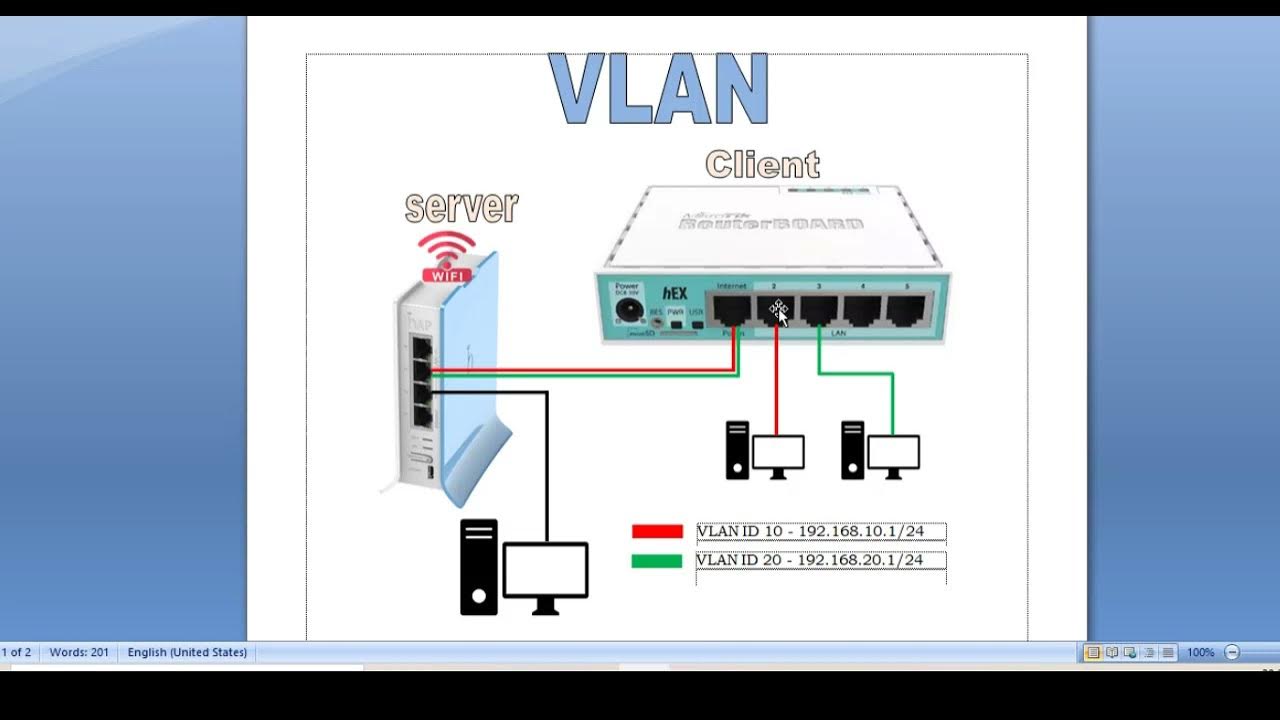VLAN INTRODUCTIONS - MIKROTIK TUTORIAL [ENG SUB]
Summary
TLDRThis video introduces a series of tutorials on VLANs (Virtual Local Area Networks) using Mikrotik devices. It explains the basic concepts of VLANs, their uses, and how they allow multiple subnetworks on the same switch. The video also highlights the difference between access ports and trunk ports, discusses VLANs' role in improving network segmentation and security, and explains how to connect multiple devices across different floors using VLANs. Viewers are encouraged to subscribe for upcoming tutorials on specific VLAN configurations for various Mikrotik products, including devices with and without switch chips.
Takeaways
- 📺 The tutorial is an introduction to VLANs (Virtual Local Area Networks) and explains their purpose and functionality.
- 🌐 VLANs are used to group multiple networks on the same switch or across multiple switches.
- 🔌 VLANs allow the use of Layer 2 and Layer 1 links to pass different services over a single physical connection.
- 📑 VLANs follow the IEEE 802.1Q protocol, commonly referred to as dot1Q.
- 📦 In Ethernet frames, a VLAN header is inserted between Ether Type and Payload when VLAN is used.
- 🔴 VLANs can be used to segregate a switch into multiple subnetworks, ensuring that specific devices (like finance or general departments) remain isolated.
- 🖥️ Manageable switches are required to set up VLANs, while unmanaged switches won't support VLAN functionality.
- 📡 VLANs can pass multiple networks through one cable using Trunk ports, saving on cable management.
- 💻 VLANs enhance network security by segregating networks, limiting potential threats like broadcast storms and virus spread.
- 🛠️ There are four ways to configure VLANs depending on the type of MikroTik device: with or without a switch chip, on CRS, and on CSS devices.
Q & A
What is a VLAN?
-A VLAN (Virtual Local Area Network) is a network protocol that allows multiple networks to operate on the same physical switch, grouping devices logically rather than physically.
What are the main uses of VLANs?
-The two primary uses of VLANs are: 1) grouping multiple networks on the same switch or across multiple switches, and 2) transmitting multiple services over a single physical cable, allowing segmentation of traffic at Layer 2.
What protocol standard does VLAN use?
-VLANs use the IEEE 802.1Q protocol standard, commonly referred to as dot1Q.
How is a VLAN header added to an Ethernet frame?
-In a VLAN-enabled Ethernet frame, an 802.1Q header is inserted between the Ether Type and Payload fields.
How does VLAN improve network management on switches?
-VLANs allow a switch to be logically segmented into different network groups, reducing the need for multiple physical switches and simplifying network management and maintenance.
What is the difference between Access Port and Trunk in VLANs?
-An Access Port allows only one VLAN to pass through, while a Trunk port can handle multiple VLANs over a single physical connection.
How does VLAN improve network security?
-VLANs enhance security by isolating network segments. This limits broadcast traffic and allows for restricted access to certain applications and devices, reducing risks like virus spread.
What are the challenges of using VLANs in multi-floor setups?
-In multi-floor setups, using separate cables for each VLAN can become inefficient and complex. VLANs allow multiple networks to share the same physical link, reducing the need for numerous cables.
What is VLAN1, and why is it special?
-VLAN1 is the default VLAN on many devices, often representing untagged traffic. It’s functionally equivalent to having no VLAN, as it includes all unsegmented traffic.
What are the different configurations for VLAN on Mikrotik devices?
-There are four configurations: for routers without switch chips, routers with switch chips, CRS devices (Cloud Router Switch), and CSS devices (Cloud Smart Switch) which use SwitchOS.
Outlines

Dieser Bereich ist nur für Premium-Benutzer verfügbar. Bitte führen Sie ein Upgrade durch, um auf diesen Abschnitt zuzugreifen.
Upgrade durchführenMindmap

Dieser Bereich ist nur für Premium-Benutzer verfügbar. Bitte führen Sie ein Upgrade durch, um auf diesen Abschnitt zuzugreifen.
Upgrade durchführenKeywords

Dieser Bereich ist nur für Premium-Benutzer verfügbar. Bitte führen Sie ein Upgrade durch, um auf diesen Abschnitt zuzugreifen.
Upgrade durchführenHighlights

Dieser Bereich ist nur für Premium-Benutzer verfügbar. Bitte führen Sie ein Upgrade durch, um auf diesen Abschnitt zuzugreifen.
Upgrade durchführenTranscripts

Dieser Bereich ist nur für Premium-Benutzer verfügbar. Bitte führen Sie ein Upgrade durch, um auf diesen Abschnitt zuzugreifen.
Upgrade durchführen5.0 / 5 (0 votes)






